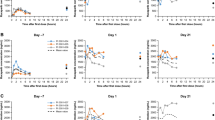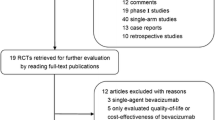Abstract
Purpose
To evaluate the pharmacokinetics of bevacizumab following IP and IV administration, and to investigate combined bevacizumab therapy (IP or IV) with IP paclitaxel or carboplatin in a mouse model of ovarian cancer.
Methods
Bevacizumab pharmacokinetics were investigated following IV or IP dosing, and mice bearing peritoneal A2780 xenografts were treated with vehicle, IV or IP bevacizumab, IP paclitaxel, IP paclitaxel with co-administration of IV or IP bevacizumab, IP carboplatin, and IP carboplatin with co-administration of IV or IP bevacizumab. Survival time was defined as the time to death or the time to reach 120% of baseline body weight.
Results
Following IP administration, bevacizumab was rapidly absorbed and bioavailability was 92.8%. Median survival time, which was 33 days for control mice, was increased by 24% with IP paclitaxel. IP carboplatin failed to increase survival time when administered alone. IV and IP bevacizumab increased survival time by 42 and 33%. Combined bevacizumab and IP paclitaxel was superior to paclitaxel alone (P = 0.01 for IV and P = 0.04 for IP bevacizumab), and combined bevacizumab and IP carboplatin was superior to carboplatin alone (P = 0.002 for IV and P = 0.02 for IP bevacizumab). There were no significant differences in survival between groups receiving bevacizumab IV or IP, either alone (P = 0.586), in combination with paclitaxel (P = 0.467), or in combination with carboplatin (P = 0.149).
Conclusions
Following IP administration to mice, bevacizumab demonstrates rapid and near complete absorption. Bevacizumab therapy, initiated prior to IP carboplatin or paclitaxel administration, increased survival time significantly in mice, and results were not dependent on the route of bevacizumab administration (IV vs. IP).



Similar content being viewed by others
References
Runowicz CD (2008) Intraperitoneal chemotherapy in ovarian cancer: an update. Cancer J 14(1):7–9
Tummala MK, Alagarsamy S, McGuire WP (2008) Intraperitoneal chemotherapy: standard of care for patients with minimal residual stage iii ovarian cancer? Expert Rev Anticancer Ther 8(7):1135–1147
Walker JL (2009) Intraperitoneal chemotherapy for ovarian cancer: 2009 goals. Gynecol Oncol 112(3):439–440
Kawai M, Kikkawa F, Hattori S, Ohta M, Arii Y, Tomoda Y (1994) Long-term follow-up of patients with epithelial carcinoma of the ovary. Int J Gynaecol Obstet 44(3):259–266
Sautner T, Hofbauer F, Depisch D, Schiessel R, Jakesz R (1994) Adjuvant intraperitoneal cisplatin chemotherapy does not improve long-term survival after surgery for advanced gastric cancer. J Clin Oncol 12(5):970–974
Ozols RF, Locker GY, Doroshow JH, Grotzinger KR, Myers CE, Young RC (1979) Pharmacokinetics of adriamycin and tissue penetration in murine ovarian cancer. Cancer Res 39(8):3209–3214
Los G, Mutsaers PH, van der Vijgh WJ, Baldew GS, de Graaf PW, McVie JG (1989) Direct diffusion of cis-diamminedichloroplatinum(ii) in intraperitoneal rat tumors after intraperitoneal chemotherapy: a comparison with systemic chemotherapy. Cancer Res 49(12):3380–3384
Dedrick RL, Flessner MF (1997) Pharmacokinetic problems in peritoneal drug administration: Tissue penetration and surface exposure. J Natl Cancer Inst 89(7):480–487
Waniewski J, Werynski A, Lindholm B (1999) Effect of blood perfusion on diffusive transport in peritoneal dialysis. Kidney Int 56(2):707–713
Flessner MF, Dedrick RL, Schultz JS (1984) A distributed model of peritoneal-plasma transport: theoretical considerations. Am J Physiol 246 (4 Pt 2):R597–607
Gupta E, Wientjes MG, Au JL (1995) Penetration kinetics of 2’, 3’-dideoxyinosine in dermis is described by the distributed model. Pharm Res 12(1):108–112
Shah DK, Shin BS, Veith J, Toth K, Bernacki RJ, Balthasar JP (2009) Use of an anti-vascular endothelial growth factor antibody in a pharmacokinetic strategy to increase the efficacy of intraperitoneal chemotherapy. J Pharmacol Exp Ther 329(2):580–591
Kobold S, Hegewisch-Becker S, Oechsle K, Jordan K, Bokemeyer C, Atanackovic D (2009) Intraperitoneal vegf inhibition using bevacizumab: a potential approach for the symptomatic treatment of malignant ascites? Oncologist 14(12):1242–1251
Hamilton CA, Maxwell GL, Chernofsky MR, Bernstein SA, Farley JH, Rose GS (2008) Intraperitoneal bevacizumab for the palliation of malignant ascites in refractory ovarian cancer. Gynecol Oncol 111(3):530–532
Armstrong DK, Bundy B, Wenzel L, Huang HQ, Baergen R, Lele S, Copeland LJ, Walker JL, Burger RA (2006) Intraperitoneal cisplatin and paclitaxel in ovarian cancer. N Engl J Med 354(1):34–43
Markman M (2009) An update on the use of intraperitoneal chemotherapy in the management of ovarian cancer. Cancer J 15(2):105–109
Covens A, Carey M, Bryson P, Verma S, Fung Kee Fung M, Johnston M (2002) Systematic review of first-line chemotherapy for newly diagnosed postoperative patients with stage ii, iii, or iv epithelial ovarian cancer. Gynecol Oncol 85(1):71–80
McVie JG, Dikhoff TGMH, Van der Heide J (1982) Tissue concentration of platinum after intraperitoneal cisplatin administration in patients. Proc Am Assoc Cancer Res 26:162
Gerber HP, Ferrara N (2005) Pharmacology and pharmacodynamics of bevacizumab as monotherapy or in combination with cytotoxic therapy in preclinical studies. Cancer Res 65(3):671–680
Lin YS, Nguyen C, Mendoza JL, Escandon E, Fei D, Meng YG, Modi NB (1999) Preclinical pharmacokinetics, interspecies scaling, and tissue distribution of a humanized monoclonal antibody against vascular endothelial growth factor. J Pharmacol Exp Ther 288(1):371–378
Liang WC, Wu X, Peale FV, Lee CV, Meng YG, Gutierrez J, Fu L, Malik AK, Gerber HP, Ferrara N, Fuh G (2006) Cross-species vascular endothelial growth factor (vegf)-blocking antibodies completely inhibit the growth of human tumor xenografts and measure the contribution of stromal vegf. J Biol Chem 281(2):951–961
Acknowledgments
This work was supported by the National Cancer Institute of the National Institutes of Health [CA118213 to J.B.], and by the Center for Protein Therapeutics at the University at Buffalo.
Conflict of interest
None.
Author information
Authors and Affiliations
Corresponding author
Rights and permissions
About this article
Cite this article
Shah, D.K., Veith, J., Bernacki, R.J. et al. Evaluation of combined bevacizumab and intraperitoneal carboplatin or paclitaxel therapy in a mouse model of ovarian cancer. Cancer Chemother Pharmacol 68, 951–958 (2011). https://doi.org/10.1007/s00280-011-1566-3
Received:
Accepted:
Published:
Issue Date:
DOI: https://doi.org/10.1007/s00280-011-1566-3




